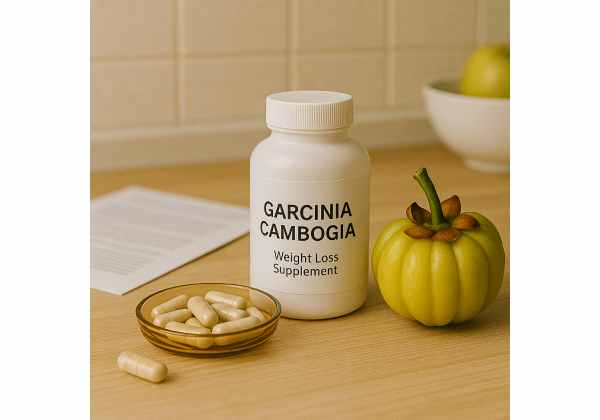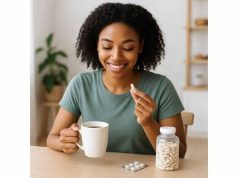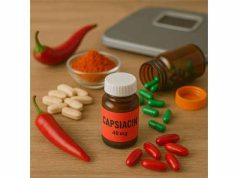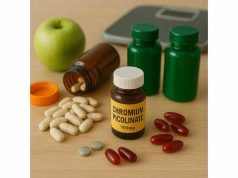
Garcinia cambogia, a tropical fruit also called Malabar tamarind, rose to fame a decade ago as a “belly-fat” solution. Bottles promised rapid results from hydroxycitric acid (HCA), the fruit’s active compound. As larger, better studies arrived and safety concerns surfaced, enthusiasm cooled. Today, garcinia is a cautionary tale: interesting biology, modest real-world effects, and quality problems that undermine trust. This guide explains what garcinia is, why evidence disappointed, how risks stack up, and what to do instead if your goal is sustainable fat loss. If you are comparing supplements with prescription options, see our plain-English overview of clinically supported weight management to understand where each tool fits.
Table of Contents
- What is garcinia cambogia and does it work?
- How hydroxycitric acid is supposed to help
- How much weight could it help?
- Safety concerns and liver risk
- Quality problems and dosing pitfalls
- Better supported options today
- If you still plan to try it
- Frequently Asked Questions
What is garcinia cambogia and does it work?
Garcinia cambogia is a small, sour fruit native to parts of Asia and used in cooking. Its rind contains hydroxycitric acid (HCA), sold in capsules and powders—often standardized to about 50–60% HCA. Labels typically suggest taking it before meals. Early, small trials and animal studies fueled excitement, but later research in humans painted a more modest picture.
What makes garcinia appealing is its simple promise: reduce fat production, curb appetite slightly, and make calorie control easier. In practice, the average effect size in controlled trials is small. Some participants report less hunger or smaller portions for a few weeks, but many notice no meaningful change. Weight differences versus placebo, when present, are usually modest and shrink as study quality improves. Real-world users face additional hurdles—variable products, inconsistent dosing, and unrealistic expectations from marketing.
Garcinia’s fade from the spotlight also reflects the maturing weight-loss landscape. We now have better-validated, behavior-friendly levers: adequate protein, fiber timing, resistance training, and, for some, prescription therapies that meaningfully reduce appetite. If you are rebuilding fundamentals, our guide to safe weight loss basics covers diet structure, movement, and sleep—the pillars that drive results with or without supplements.
Key points to keep in view:
- “Standardized” does not guarantee effective dosing; HCA percentage and total milligrams both matter.
- Appetite effects, if present, are usually mild and may wane with time.
- Quality and labeling vary widely across brands, which affects both efficacy and safety.
How hydroxycitric acid is supposed to help
Marketers often describe HCA as a “fat blocker.” The real biology is subtler. HCA can inhibit ATP-citrate lyase, an enzyme involved in de novo lipogenesis (the conversion of carbohydrate to fatty acids). In theory, this diverts some energy away from new fat storage and toward glycogen (the carbohydrate stored in muscle and liver). Higher glycogen levels may send “enough fuel” signals that slightly reduce appetite.
That mechanistic story has caveats:
- Human metabolism rarely makes much new fat from everyday diets. De novo lipogenesis ramps up mainly when calorie intake is high and carbohydrate is very high for sustained periods. In a calorie deficit, this pathway contributes less to body fat.
- Bioavailability varies. HCA comes as different salts (often calcium or potassium). How well your body absorbs and uses each form differs, and not all labels clarify the chemistry.
- Dose and timing matter. The enzyme effect is short-lived; if HCA is under-dosed or taken inconsistently, the theoretical benefit is easy to miss.
You will also see claims that HCA “boosts serotonin” and reduces emotional eating. Evidence for meaningful mood effects is inconsistent and, in sensitive individuals, raises safety questions (see the safety section for antidepressant interactions). Treat mood claims with caution.
If you are comparing labels and trying to decide whether any given product is plausibly dosed, our primer on reading supplement labels shows how to check the actual HCA per serving, not just the extract weight or a percentage without context.
How much weight could it help?
Short answer: less than the hype promised, and often not enough to notice without strong lifestyle support. Across controlled trials lasting 8–12 weeks, average extra loss versus placebo is small—commonly well under two pounds. Many studies report no statistically significant difference at all. Effects, when present, tend to show up as slightly smaller portions or fewer between-meal snacks, not as dramatic fat loss.
Why the gap between promise and reality?
- Study design issues. Early, positive studies were small, short, and sometimes lacked rigorous controls. As methods improved, effect sizes shrank.
- Heterogeneous products. “500 mg” on a label might refer to extract weight, not HCA content. Two products with the same capsule size can deliver very different doses.
- Adaptive biology. Even if appetite dips for a week or two, your brain often nudges intake back toward baseline. Sleep, stress, and environment frequently outweigh marginal biochemical nudges.
- Behavioral context. A capsule cannot fix large, liquid calories, ultra-processed snacks at arm’s reach, or inconsistent protein intake.
What does “realistic success” look like if you respond? You might notice you leave a few bites on the plate or skip an afternoon snack you usually reach for. Spread over weeks, that could trim a few hundred calories—helpful but not transformative. If you want a fair comparison with other “natural” options that gained attention yet underdelivered in better trials, see our review of green coffee bean extract and why many users ultimately moved on.
Ultimately, garcinia is best understood as a low-impact adjunct—and for many, not a necessary one. Placing attention on protein, fiber timing around key meals, and resistance training tends to yield more visible results per dollar and per minute of effort.
Safety concerns and liver risk
Garcinia is marketed as “natural,” but natural does not guarantee safe for everyone. Most people who try it experience only mild issues—nausea, digestive discomfort, or headache—especially when starting or when doses climb quickly. More serious concerns, however, are the main reason garcinia fell out of favor.
Liver injury reports. Case reports and safety alerts have linked multi-ingredient weight-loss products containing garcinia with acute liver injury. Causation is hard to prove in blended products, but the pattern has raised caution among clinicians. Symptoms to watch for include fatigue, dark urine, abdominal pain, itching, and yellowing of the skin or eyes; stop immediately and seek medical care if these occur.
Potential interactions. HCA may influence neurotransmitters in ways that could interact with certain psychiatric medications. People taking antidepressants or mood-stabilizing drugs should avoid garcinia unless cleared by their prescriber. Individuals with diabetes who use medications that lower blood glucose should also discuss garcinia with their care team, as appetite shifts and carbohydrate handling can affect dosing needs.
Who should not use it.
- Pregnant or breastfeeding individuals.
- Anyone with known liver disease or unexplained abnormal liver tests.
- People with a history of severe anxiety, mania, or panic disorders.
- Adolescents; prioritize nutrition, growth, and clinician-guided care.
Practical safety steps if you consider a trial. Choose a product with clear HCA content, avoid stimulant stacks, and prefer brands that publish independent testing data. For help vetting labels and certifications, see our explainer on third-party testing and why it matters.
Quality problems and dosing pitfalls
Even if HCA had robust effects, inconsistent quality would still sabotage outcomes. Common pitfalls include:
- Label sleight of hand. Some bottles list the extract weight (e.g., “1,000 mg garcinia”) but not the actual HCA per serving. If it is “60% HCA,” then 1,000 mg extract equals 600 mg HCA—not 1,000 mg HCA. Other labels cite a percentage without confirming the extract weight at all.
- Unclear salt forms. HCA bound to calcium versus potassium can change how much active compound you absorb. Few products disclose this clearly.
- Proprietary blends. Multi-ingredient “burners” often tuck garcinia into long lists without a dose, making efficacy and safety impossible to judge.
- Overpromising timelines. Claims like “melt fat in 7 days” set up frustration. In trials where any benefit appeared, it accumulated slowly and depended on calorie control.
If you were to design a product that maximizes a fair trial, it would: disclose HCA milligrams per serving, specify the salt form, verify purity through a credible lab, and provide cautious dosing instructions with meal timing and medication separation. Many retail products do not clear this bar.
What about combining garcinia with caffeine, green tea extract, or synephrine? Stimulant stacks may feel more noticeable, but they raise side-effect risk without fixing garcinia’s small average effect. If you want to experiment with a mild, single-ingredient thermogenic, compare pros and cons of caffeine in our concise guide to effective doses and safety—and keep sleep as a non-negotiable guardrail.
Better supported options today
Garcinia’s decline coincides with stronger, more practical tools for appetite and adherence. Consider these paths, matched to common sticking points.
If portions feel out of control:
Soluble fiber before meals, protein at each meal, and a consistent plate structure reduce friction better than most botanicals. A simple routine (e.g., psyllium in water 20 minutes before dinner) often outperforms a rotating supplement stack.
If cravings derail you after 3 p.m.:
Plan a protein-plus-fiber snack between lunch and dinner, prioritize sleep, and schedule a brief walk after the afternoon meal. Caffeine earlier in the day can aid training but should not push into the evening.
If BMI and medical risks are high:
Discuss prescription options with your clinician. Modern incretin-based therapies can deliver clinically meaningful weight loss when paired with nutrition and activity. For an accessible overview of how they work and what to expect, see our guide to GLP-1 medications.
If you want a supplement at all:
Favor single, standardized ingredients with clear dose-response data (e.g., fiber timing, caffeine with training). Introduce one variable at a time and measure what changes—hunger ratings, snack frequency, and training quality—rather than chasing scale noise across days.
If you still plan to try it
If you decide to trial garcinia despite its small average effect, treat it as a structured experiment with stop rules.
1) Get clearance first.
If you have liver disease, take psychiatric or diabetes medications, are pregnant or breastfeeding, or have any history of mania or panic, do not use garcinia unless your clinician explicitly approves.
2) Choose a transparent product.
Look for a label that states HCA milligrams per serving, clarifies the salt form, and shows independent testing. Avoid proprietary blends and stimulant stacks.
3) Start low and time it.
Begin with a single serving before the largest meal for 3–4 days. If well tolerated and you notice less hunger, consider adding a second serving before another meal. Separate from medications by at least two to three hours.
4) Track what matters.
Log hunger on a 1–10 scale before and after target meals, snack frequency, and total sleep. If nothing changes by week two, stop. Do not escalate doses to “force” an effect.
5) Know red-flag symptoms.
Stop immediately and seek care for dark urine, unexplained fatigue, abdominal pain, itching, yellowing of the eyes or skin, or persistent nausea/vomiting.
6) Keep expectations realistic.
Best-case improvements show up as small, behavior-friendly changes to portions and snacking—not as dramatic weekly weight drops. If your time, money, and attention are limited, invest them where the returns are largest: food structure, protein, fiber timing, and resistance training.
Frequently Asked Questions
Why did garcinia cambogia fall out of favor?
Later, higher-quality trials showed small or no weight-loss advantages over placebo, while reports of liver injury with garcinia-containing products raised safety concerns. Combined with inconsistent product quality and overhyped marketing, many clinicians and consumers shifted toward better-supported strategies.
Does garcinia cambogia actually help with weight loss?
Any benefit is usually modest—often too small to notice without diet structure. Some people report less hunger for a short period, but average weight differences versus placebo are small. Sustainable loss depends on calorie control, adequate protein, fiber timing, movement, and sleep.
Is garcinia cambogia safe for the liver?
Most users do not experience severe problems, but case reports have linked garcinia-containing products to acute liver injury. Stop immediately and seek medical care if you develop dark urine, abdominal pain, itching, fatigue, or yellowing of the skin or eyes.
Can I take garcinia cambogia with antidepressants?
Not without medical guidance. Because hydroxycitric acid may influence neurotransmitters, there is potential for interactions with psychiatric medications. If you take antidepressants or mood stabilizers, avoid garcinia unless your prescriber approves and monitors you.
What dose of HCA is effective?
Labels vary widely. Products often list extract weight rather than true HCA content, and trial doses associated with small effects still produced modest outcomes. If a label does not disclose HCA milligrams per serving and salt form, it is not possible to judge efficacy or safety.
What should I use instead of garcinia?
Focus first on behavior—protein at each meal, fiber before key meals, resistance training, steps, and sleep. If medical risks are high, discuss prescription options with your clinician. Selected single-ingredient supplements with clear evidence can help some people, but none replace fundamentals.
References
- Effect of Garcinia cambogia supplement on obesity indices: A systematic review and dose-response meta-analysis (2020) (Systematic Review)
- Garcinia cambogia, Either Alone or in Combination With Green Tea, Causes Moderate to Severe Liver Injury (2022) (Safety Study)
- Quality Evaluation of Dietary Supplements for Weight Loss Based on Garcinia cambogia (2022) (Quality Study)
- Binding of hydroxycitrate to human ATP-citrate lyase (2017) (Mechanistic Study)
- Acute Severe Liver Injury Related to Long-Term Garcinia cambogia Intake (2020) (Case Report)
Disclaimer
This article provides general information for educational purposes and does not replace personalized medical advice, diagnosis, or treatment. Always consult a qualified healthcare professional before starting or stopping any supplement or medication, especially if you have liver disease, take psychiatric or diabetes medications, are pregnant or breastfeeding, or have other chronic conditions.
Share and follow
If this guide clarified why garcinia lost momentum—and what to do instead—please share it with someone sorting through supplement claims. For steady, evidence-based updates, follow us on the social platform you use most. Your questions and feedback help us refine future guides.










